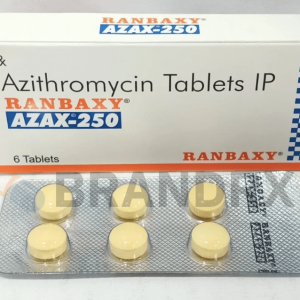Description
Azithromycin is an antibiotic from the macrolide-azalide group, which has a bacteriostatic effect and a broad spectrum of action against gram-positive and gram-negative bacteria.
Administration of azithromycin is prescribed in the case of confirmed bacterial forms of infection. The drug belongs to the group of macrolide and azalide antibacterial agents. The active ingredient is chemical in nature and a complex multi-level formula. The medicine belongs to the third generation of bactericidal preparations with minimal resistance to it from various pathogenic bacteria. This allows the drug to be used in various forms of inflammatory diseases. The main form of use are gelatin capsules, inside which there is a white crystalline powder. The capsules must be whole, without pre-opening. This is due to the fact that the hydrochloric acid of the gastric juice can negatively affect the components of the drug. The capsular shape allows it to be transmitted unchanged to the cavity of the small intestine, where there is no aggressive acid medium.
Pharmacological effect
The main effect of Azithromycin is directed against a wide range of bacterial forms of infections. When ingested, the active substance comes into contact with the inclusion of the cell's ribosomes. Due to the formation of persistent bonds, the production of protein compounds within the bacterial cell is blocked. Therefore, with therapeutic dosages, a bacteriostatic process is achieved with the slowing and suppression of fission and the multiplication of bacterial microflora. To quickly destroy the microbial flora, an increase in the concentration of the active substance in the blood plasma is required.
Azithromycin to Treat Various Bacterial Infections – Overview
The number of bacteria sensitive to this drug includes:
- All types of streptococci;
- Bordetella and Campylobacteria;
- Anaerobic microflora;
- Mycoplasma and ureoplasma.
In some cases, the instructions for use of azithromycin can be used to damage tissues with a spirochete.
After ingestion, the active ingredient penetrates the blood for 30 minutes. After one hour, the plasma concentration reaches 38 percent. Maximum bioavailability occurs 2 hours after taking a therapeutic dose of 500 mg. For full-fledged treatment, it is necessary to take an azithromycin antibiotic for at least 3 consecutive days. In severe forms of infection, longer courses of treatment are required.
Indications for the use of azithromycin:
- Acute upper respiratory tract infections, including tonsillitis, sore throat,
pharyngitis, tracheitis; - Acute and chronic infections of the lower respiratory tract – bronchitis, bronchiolitis,
bronchiectasis, pleurisy, pneumonia; - Otitis media in the acute phase;
- Frontitis, ethmoiditis, maxillary sinusitis;
- Acute urethritis and cystitis;
- Pyelonephritis caused by sensitive microflora;
- Inflammatory processes in soft tissues – erysipelas, dermatosis and dermatitis with a purulent
removable substrate; - Cholecystitis, duodenitis, peptic ulcer of the stomach and duodenum.
In dentistry, azithromycin 500 mg is used for acute forms of adnexitis and bacterial vaginitis. This drug is likely to help prevent the risk of adhesions and obstruction of the fallopian tubes.
The drug azithromycin 250 mg is effective in diseases of the oral cavity. In particular, its use is widely practiced with fluxes, periostitis and periodontitis. After tooth extraction and suppuration, the wells can also be prescribed for taking this drug.
It does not have sufficient efficacy for diseases of the cobwebs of the brain and does not have a pathogenic effect on meningococcal forms of infection. Therefore, with meningitis, encephalitis and arachnoiditis are not used as a first choice drug. But it can be used as an auxiliary preparation in complex antibacterial therapy.






Reviews
There are no reviews yet.